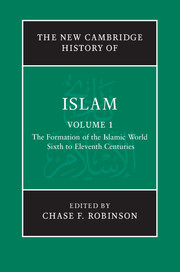Book contents
- Frontmatter
- Introduction
- PART I THE LATE ANTIQUE CONTEXT
- PART II UNIVERSALISM AND IMPERIALISM
- PART III REGIONALISM
- PART IV THE HISTORIOGRAPHY OF EARLY ISLAMIC HISTORY
- 15 Modern approaches to early Islamic history
- 16 Numismatics
- 17 Archaeology and material culture
- Conclusion: From formative Islam to classical Islam
- Glossary
- Bibliography
- Index
- Plate Section
- References
16 - Numismatics
from PART IV - THE HISTORIOGRAPHY OF EARLY ISLAMIC HISTORY
Published online by Cambridge University Press: 28 March 2011
- Frontmatter
- Introduction
- PART I THE LATE ANTIQUE CONTEXT
- PART II UNIVERSALISM AND IMPERIALISM
- PART III REGIONALISM
- PART IV THE HISTORIOGRAPHY OF EARLY ISLAMIC HISTORY
- 15 Modern approaches to early Islamic history
- 16 Numismatics
- 17 Archaeology and material culture
- Conclusion: From formative Islam to classical Islam
- Glossary
- Bibliography
- Index
- Plate Section
- References
Summary
Islamic coins as a historical source
At least since Leopold von Ranke (1795–1886), the historical-critical approach to any study of history has demanded parallel independent proof in order to establish firmly a given historical fact. Historians of Islamic societies have almost no primary documents or archives for the period prior to the fifteenth century. In contrast to the scarce primary documents, the secondary sources – literary and historical accounts, especially from the ninth to the tenth centuries – are abundant.
This gross imbalance between the lack of primary documents, produced in the course of the events, and chronicles written much later has led scholars to depend greatly upon medieval but secondary authors. Since they typically wrote from the point of view of a city, a ruling house, a ruler or a religious community or school of law their accounts are necessarily biased. Without independent documents or material evidence the modern historian is often unable to corroborate or to refute these literary accounts; sometimes even important lacunae in our knowledge may remain unnoticed. After being widely neglected following the First World War the study and use of Islamic numismatic documents have again become a prospering academic subject, particularly in the 1990s.
Keywords
- Type
- Chapter
- Information
- The New Cambridge History of Islam , pp. 648 - 663Publisher: Cambridge University PressPrint publication year: 2010
References
- 10
- Cited by



